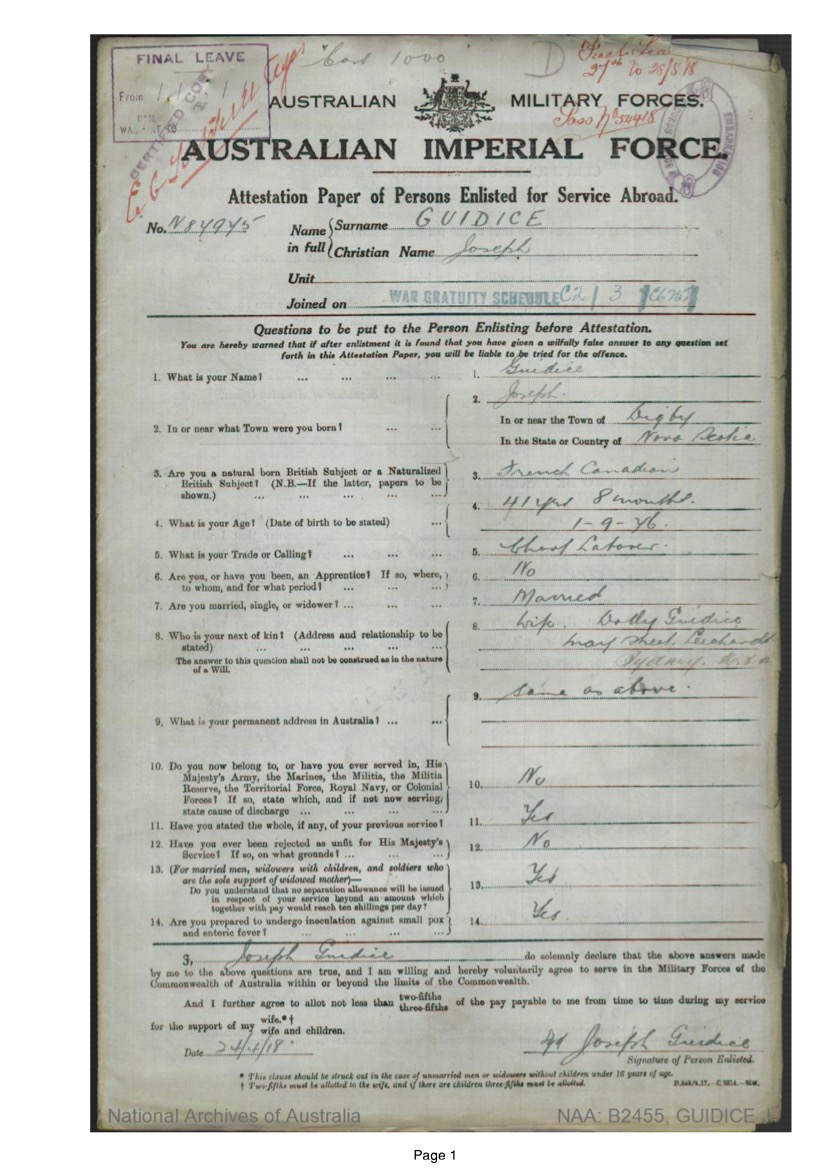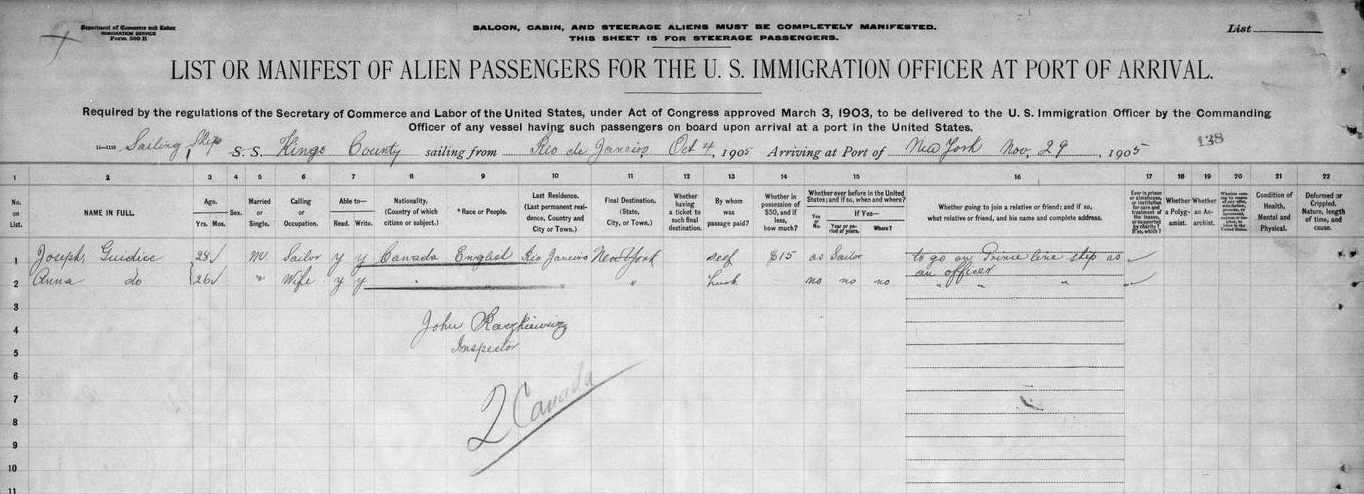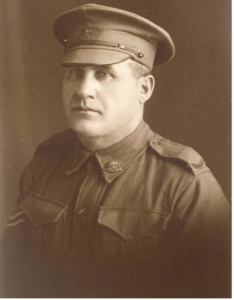Joseph Guidice: An Enigma wrapped in several Mysteries. An electronic records investigation.
I came across Joe in the early 2010s while looking for photographs of Australian World War One soldiers for a presentation, I had found his photo on the State Library of New South Wales website. He enlisted in the Australian Army in 1918, but as he was of Canadian nationality, I didn’t use his image for my talk. However, I didn’t forget him because the question intrigued me, what was a Canadian doing enlisting in the Australian Army? I eventually went looking.

Attestation paper of Joseph Guidice. National Archives of Australia ref: NAA_ItemNumber4391823.
The first place I looked was the National Archives of Australia and where I downloaded his WW1 dossier. The attestation pages stated that he was 41 years 8 months old, was a wharf labourer, married to Dolly, lived in Leichardt in Sydney, was born in Digby, Nova Scotia (Canada) and was French Canadian. This information led to many mysteries.
Firstly, his surname. Guidice is, as far as I can determine, a surname of Italian origin. I checked online Canadian birth records, and there are no Guidice’s born in Nova Scotia around 1876. Unfortunately, the online records only go to 1877! If that is where he is from, a name transposition must have taken place at some point. Also, Nova Scotia has solidly Anglo ancestry – there were not many French Canadians there, but he had always identified as French Canadian.
Secondly, why did he join up at such an age? It was probably an economic decision, but there is no proof available. Besides, he only lasted 6 months and was medically discharged with the war ending shortly after.
Thirdly, Dolly was not his wife. They only lived together. More about her later.
Fourthly, how did he get from Canada to Australia? By ship obviously, but when and where? When doing an in-depth search, the first mention of Joe that I found was in a passenger record for 1905 at New York. The name was correct, age was close, he was listed as a ship’s officer, travelling to join a new shipping company, had $15.00 cash and was French Canadian. He also had a wife, Anna, with him and the ship arrived from Rio de Janeiro, Brazil. Who was Anna? Why Brazil? More questions to answer. Sadly, I have found no further mention of Anna, anywhere. However, she was the first of a string of liaisons for Joe.

1905 passenger list showing a Joseph Guidice as a sailor. MyHeritage.com record image.
The next mention of Joe that I found was in another shipping record here in Australia in 1910. He was travelling between Brisbane and Sydney and had apparently been here for a little while, arrival date is unknown. It may have taken some time for Joe to travel to Australia, as the Panama Canal did not open until 1914. Considering he had once sailed from Rio in 1905, perhaps he came the long way round, or maybe he crossed the USA by rail.
These 1910 shipping notices show Joe travelling from Brisbane to Sydney and back again. From subsequent news items, other than passenger notices, it seems that he was in Brisbane for some time. In a newspaper article dated 09 March 1913 Joe claimed to have been working for four years in Brisbane as a master sailmaker with the A.U.S.N. company [Australasian United Steam Navigation company], which, it seems was long enough for him to be involved with two possibly different women.
The first of these women was Sarah May Rodgers, how they met is unknown, and while Joe may have been happy with the relationship, Sarah’s husband was not. He named Joe as the co-respondent in the ensuing divorce proceedings in 1911 and was successful. Nothing further is conclusively known about Sarah.
The second relationship was with a woman known severally as: Selena Odgers, Dolly Burns and Dolly Guidice. Could Selina and Sarah have been one and the same person, because Rodgers and Odgers are similar surnames missing the first letter? I don’t know. They were both located in Brisbane when Joe knew them.

Article from NSW Police Gazette and Weekly Record of Crime. National Library of Australia
Dolly followed Joe to Sydney when he moved there. She is the Dolly named as Joe’s wife on his Attestation papers, although they were not married. Joe even stated this in one of the newspaper articles he was mentioned in, but why all these newspaper articles? Joe and Dolly had a very rocky, on-off relationship over a 7 to 8 year period, with her leaving him at times for up to a month, but always coming back. Dolly had a liking for drink, was charged with stealing at least once, was suspected of being a casual prostitute, and was possibly assaulted by Joe on at least one occasion. All these things led to court appearances and made for good newspaper copy; reporters then, as now, knew a good story when they saw one.
In January 1919 Joe and Dolly’s relationship apparently came to a head. She received money from Joe and went on a binge. At about 6pm on 23 January she threw herself off Watson’s head. She left a note at the top of the cliff saying. “My life has been too sad. So, I’m going where I will find some rest.” A witness saw her actions, so Joe did not become a suspect in her death.
How this affected Joe is not known. However, on 09 June 1920 Joe married Bertha Louisa Francisco Cumming, a 31-year-old widow, in Sydney. Also, about this time, a string of adverts started appearing in Sydney newspapers for a business producing shade sails, animal blankets and many other canvas goods and listing Joe as the proprietor. These adverts, even in the Chinese language newspapers, appeared for several years, although Joe seemed to have a string of partners in the business. In the late 1920’s these adverts disappeared.
In 1929 Joe was again at sea. A string of crew lists at New York has him arriving as an A.B. (Able Seaman) on various ships. Being an Able Seaman is a bit of a comedown for a man who had been a Second Officer, but it seems that as he had been away from the sea for some time, he had to start at the bottom again. He was first taken on board at a place called Talara, in Chile. How he got there is unknown, though I am sure there is a record somewhere – just not an electronic one.

Portrait of Joseph Guidice. Thanks to State Library of New South Wales.
Why he was back at sea is another unknown. Possibly his canvas business failed, and perhaps his marriage was in difficulty as well and Joe went back to the only living he was good at, the sea. But the sea may not have been kind to him this time.
Working as an Able Seaman at his age would have been very hard work. It appears that he injured his back at some time, whether working in the canvas trade or back at sea. The work as a sailor may have exacerbated the injury. Whatever the reason, Joe turns up in the electronic records again, on 09 January 1933, back in Sydney, in hospital for an operation on his back. Unfortunately for Joe, he had a bad reaction to the anaesthetic and died on the operating table. The anaesthetic, Percaine, was a new one and had only been available for a few years.
Joe’s funeral was held on 11 January 1933, and he was buried in the Catholic Cemetery, Botany.
Joe’s record has some large gaps in it, but it is consistent as every record found listing Joe Guidice in this investigation, is chronologically sound. He does not appear in two different places at the same time. Whether he is listed in New York, Rio de Janeiro, Talana Chile, or Brisbane and Sydney in Australia, there is no overlap. Additionally, Joe always identified as a French Canadian, my conclusion is that these records all relate to the same person, even if widely separated around the world. Joe was a travelling man.

Thanks Geoff. That’s a fascinating tale. I wonder if there are any relatives chasing his story?
Hello Di,
Thanks for your comment.
I am not aware of any relatives looking for him at the moment.
Very interesting story Geoff. Joe’s life was journey with many twists and turns.
What a mystery man Joe seems to have been, Geoff. You grabbed my interest in the first paragraph with Joe being French Canadian and somehow enlisting in the Australian Army.